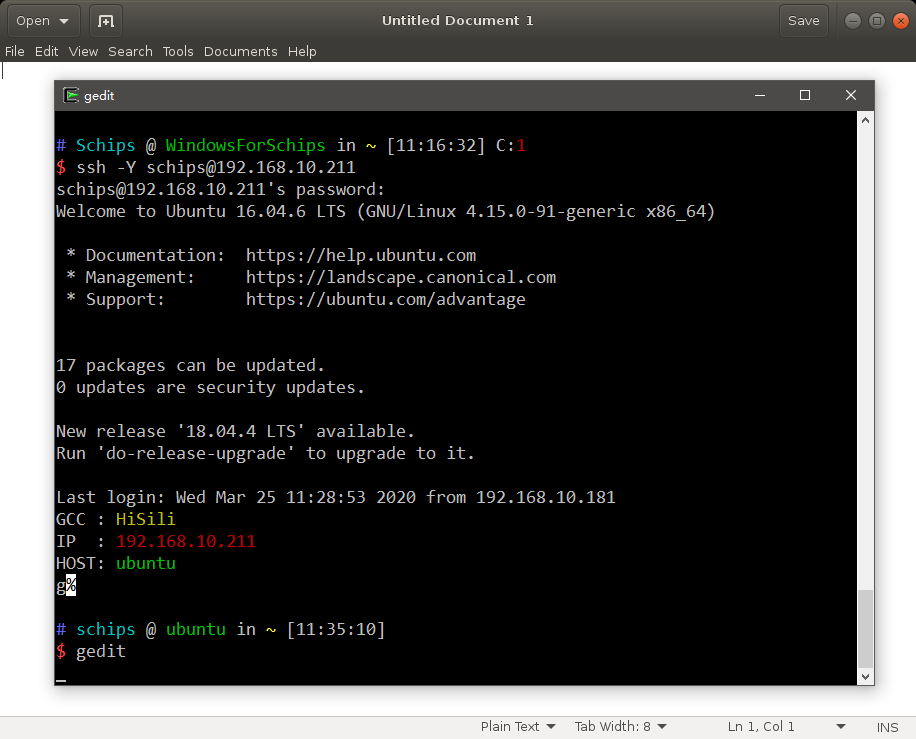Even though ForwardX11 and ForwardX11Trusted are set to Yes in your /.ssh/config, use the -Y (or -X if you don't trust the connection) switch when connecting: ssh -Y workcomputer I'm not sure why this is required but for some reason it doesn't forward X11 without the switches for me. To enable X11 Forwarding on a server client edit the file “ /etc/ssh/sshconfig ” and on ssh server edit the file “ /etc/ssh/sshdconfig ” and perform the following respective configuration changes. For CentOS/RHEL 5,6 X11 Forwarding Uncomment the line “# ForwardX11” and Change “ForwardX11 no” to “ForwardX11 yes”. I still receive the following when ssh into the server and trying to run xclock. Xclock Error: Can't open display: Here are some details. Server side (ubuntu laptop) /etc/ssh/sshdconfig. X11Forwarding yes X11DisplayOffset 10 which xauth /usr/bin/xauth Client Side (raspberry pi) /.ssh/config. ForwardX11 yes ForwardAgent yes. Using any text editor, edit or create the software installation owner's /.ssh/config file. Ensure that the ForwardX11 attribute in the /.ssh/config file is set to no. For example: Host. ForwardX11 no; Ensure that the permissions on /.ssh are secured to the Oracle installation owner user account.
Last updated: 16 Feb, 2018 Copy Copied To run X applications (such as xclock,emacs,totalview, etc) on the X client host (for example, a NAS system such as pfe21, etc.) and display them back to an X server (such as your local system), the simplest way is to use X11 Forwarding. If you are using a NAS-supported workstation or compute server, X11 Forwarding is already set up for you. The following command activates X11 Forwarding automatically: Most modern client software support this option (for example, Cygwin, TeraTerm, PuTTY, Unix, and Linux). To use X11 Forwarding, the server-side daemon (sshd) configuration file must contain the entry: to support the forwarding capability. All NAS-supported hosts (including all workstations and compute servers) honor this setting in the default sshd_config file (for High End Computing systems and Linux systems, it is /etc/ssh/sshd_config; for Mac systems, it is /etc/sshd_config) For other non-NAS machines, ask your system administration to set this in the sshd_config file. In addition to setting X11Forwarding yes on the server side (for example, a NAS machine), it is recommended that ForwardX11 yes is also set in the ssh_config file on the client host (for example, your local system). By default, NAS and HEC system configurations will enable these settings for both client and server. If ForwardX11 yes is not set in the ssh_config file by the system administrator of your local system, you can set it in your ~/.ssh/config file or use the -X option of . Other parameters related to the performance of X11 Forwarding are handled by the NAS-recommended ssh_config file. If you are on a NAS-supported system, no action is needed in setting these parameters yourself. If your local system is not supported by NAS and you would like to get configuration ideas, you can look at /etc/ssh/ssh_config on any NAS high-end computing system, such as pfe[20-27]. ExampleTo run an X11-based application, for example, xclock, on pfe21.nas.nasa.gov and have it displayed on your local system, do the following: To run an X11-based application on a NAS-supported desktop, follow the example below: If ForwardX11 yes is not set in either the ssh_config file or the ~/.ssh/config file of your local system, use: WARNING: The daemon sets the DISPLAY environment variable by itself. DO NOT RESET it to point to display zero (for example, setenv DISPLAY your_local_system:0), otherwise X11 Forwarding will not work. WARNING: For each new login, the .Xauthority file gets updated. If you are over your quota, this file cannot be updated and you get the error: X11 Forwarding will not work if you receive this error. |
If you are on a remote terminal, and the local system has only one visual (which is typical), then use the following syntax to set your user account DISPLAY environment variable:
Remote Display
Bourne, Korn, and Bash shellsC shellFor example, if you are using the Bash shell and if your host name is local_host, then enter the following command:
X11 Forwarding
To ensure that X11 forwarding does not cause the installation to fail, use the following procedure to create a user-level SSH client configuration file for Oracle installation owner user accounts:
Using any text editor, edit or create the software installation owner's
~/.ssh/config file.Ensure that the
ForwardX11attribute in the~/.ssh/configfile is set tono. For example:Ensure that the permissions on
~/.sshare secured to the Oracle installation owner user account. For example:
Ssh Forwardx11 No
Parent topic:Creating Operating System Oracle Installation User Accounts

